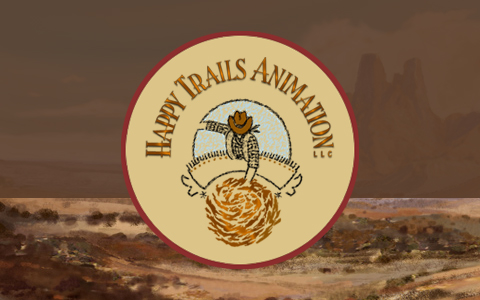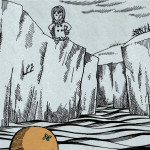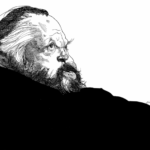Happy Trails Animation’s Andy Collen – Advice for Aspiring Animators
Written by Robin Wilding | May 13, 2011
View this Article from Animation Career Review site
Andy Collen has been animating since the days of puddling (a term coined for inking cells)–and sure has come a long way. Two decades ago Andy left sunny L.A. For Portland, Oregon—a city Andy describes as “a small town with the talent of a big city wrapped up in an independent, rebellious package!”.
In 1991 Andy, along with his wife, started up Happy Trails Animation, and the two have been growing it ever since. Andy has a profound understanding of the business and believes that interesting animation takes time, which is why newbies can become disillusioned. It is for this reason that he has filled his office with some of the best in the business after scooping talented animators from big name animation companies like O Entertainment and Disney—a move that has served Happy Trails quite well.
AnimationCareerReview recently caught up with Andy, and he offered us some pearls of wisdom for aspiring animators.
What is your firm’s focus within animation and what led your firm to have such a focus?
Our focus is in combining all the elements of traditional animation (illustration, movement and story) with various materials and methods. We find the best way to bring the elements together to bring the message front and center. We like it when our animation looks handmade.
My wife and I have been at this since we were freelance animators from 1989-1992 for Joanna Priestley, Will Vinton (California Raisins), and Jim Blashfield (king of MTV music videos for Tears For Fears, Michael Jackson, Paul Simon and many more). In 1993 we decided to create a studio of our own…Happy Trails Animation. Other studios had specific styles — we simply loved the art of animation (especially the organic styles being made in Canada at that time) and chose to focus on movement and not to work in a particular style. We chose fine-art approaches (sand, chalk, paint, paper) rather than commercial driven methods of production. I always felt (and still do) that commercial work is about matching the concept with the right animation technique to create a hard sell or punch.
Fill in the blank: The future of animation is_______________.
The future of animation is always changing.
What are the best and worst aspects about working in the animation filed?
As an animator on a team: I think the best aspect of working in the animation field is the camaraderie that can develop within the group. I think the best and worst thing is getting the gig and then when the gig is over. It is a bit like having a child and then letting it go… only it happens with each and every project.
As a person who hires animators: We are living in a time where the passion for animating is often perceived as something to make money at – preferable to flipping burgers. When I got into animation back in the mid 80’s there were only a handful of animation schools. I chose the old-school approach by mentoring under a grad wizard (Tom Arndt). Well, he is not a real wizard, but he does know a bit about magic and in fact that is what drew him to animation — the art of illusion.
In the past, without the luxury of computers, animation was all about passion. The team of animators worked on projects until they were exhausted, then got back up to start again. Now that it is possible to “undo”, standards have dropped and super-simple shows like South Park, Life and Times of Tim are the shows influencing students to become animators. They don’t realize that these shows are more about writing than animation — worse than old episodes of Speed Racer.
Students tend to want to know what programs they should learn, when it is less about the programs and more about what will they bring to the table as an artist? Theories? Show me new magic tricks in animation — like Tom. Learn color theory to give your paintings more depth. Practice manual in-betweening to improving the timing of your animation so that it is less ‘out-of-the-can’.
One of the worst aspects from a hiring aspect is that students have less of an understanding of team effort when it comes to helping the studio to succeed. Talking, tracking and just general overall communication is very important. They are unaware that how much they get paid is based on what the job brings in — not about how awesome they are as an individual. Students have less of an understanding about all the pressures that studios have to deal with, such as that the larger the client is, the more they tend to withhold payments for up to 90 days. Can studios push payments to talent back 90 days? Seems like it would be fair! Yet most studios seem to find a way to have a steady pay schedule even though the studios don’t get paid regularly. I really miss the old days of where everyone really was part of a team just trying to get every project over the finish-line before the time ran out.
Among your firm’s achievements, which one(s) are you the most proud of ?
There are a few but it always seems to be the personal projects that we get the most out of. We make short films as a way to explore new methods — but they end up being much more. The two films I should mention are “Hero Sandwich” and “Winter”.
The first short film, “Hero Sandwich”, was inspired by an impromptu voice recording that Amy and I made of my Mom and Dad talking about trying to be heroes but actually fumbling the pass…if you know what I mean. This was the first animated film to use colored sand paintings. The best part about this film was that everywhere it showed, the audience would talk amongst themselves afterward, telling their own stories. It was awesome to create a short film that inspired folks to share embarrassing moments. It was quite touching to witness this at a few major film festivals.
The second was a hand-drawn film called “Winter/En Hiver“. This film was inspired by a dream that Amy had about her mother and we built the story out around a theme of childhood, love and the threat of loss. We found a style that matched the message — a quill pen approach similar to that of American illustrator Edward Gorey. The best part about this film was again, when the film was over, the audience would discuss whether the mother was alive or not in the end. To us it seemed magical because, after seeing our film, audience members would be posed with the age-old question of “half full or half empty?” Many times we were asked “is the mother alive at the end?” and we would answer “what do you think?” Regardless of the fact that we knew the ending, it really was more about how the viewer wanted to view it. Art truly is subjective. Winter/En Hiver did very well in festivals, winning awards and traveling all around the world.
Short films do not usually have much more life beyond the festival circuit but it is fun to connect and see just how well your messages are received. This is even more valuable than working on some big name movie or major advertising campaign… it goes back to the heart and soul of what animation really is about.
What skills/qualities does your firm seek out when hiring new animators?
In addition to exceptional life-drawing skills, a natural talent for movement and being versatile with software (Photoshop / Flash / Illustrator / After Effects) we want to see passion! We want high standards and enthusiasm. We want them to be dedicated to getting things done, and that may mean working on things over and over again under pressure.
Animation is about working together as a team, so they need experience at working with others — even if this means having worked at a diner during rush hour. Team experience is crucial when working together to meet a deadline for Disney. If they have no experience like that, then it is hard to put them on the line of fire. As a studio supplying services, when your neck is on the line to a company like Disney you need to hire those who can handle the heat. Animation has a way of ebbing and flowing and you can’t be a person that gets frazzled or crumbles under pressure (at times it can be a bit like working with Gordon Ramsey). Even though a talented person can draw or build models in 3D, they still need the ability to function under pressure, with a smile. Obviously we want talented people who are skilled with drawing, software and have an eye for quality…but ultimately it is equally important that they be able to work in a collaborative environment under pressure.
What particular schools, if any, does your firm recruit new hires from? If none, where do you recruit new hires?
There are a few… we have a few folks from Cal Arts and Savannah School of Art and Design, Pacific NW College of Art and Portland Art Institute.
What advice would you give to aspiring animators?
Don’t just study animation — take politics and business classes. The world of animation is centered around business and you should learn a bit about how that system works so that you can become a valued tool in the world of animation.
What were your most challenging projects, and why?
“Hero Sandwich” was one of our most challenging films to make. Because the story involved funny back-to-back stories related to handicapped parking, and we wanted to animate with sand to give the film an organic, colorful, down-to-earth look. At that time sand animation could only be shot as front light or back light which made the footage black and white (front light means that the view is literally looking into a sand box — back light means you see the sand as a black solid object scooting across the frame) and we wanted a full-color treatment.
We did not use a computer or scanning system for this film — it was old-school, down shot on the 35 mm Oxburry stand. We also needed to find the right sand with just enough flex of black and white peppery color so that it looking like sand and not just a bunch of blurry pixels on the screen. Also, sand is not easy to color, but we figured it out and in 1996 Hero Sandwich became the first-ever colored sand film! It took a lot of R&D but when we were finished if was awesome! It is when you challenge yourself that you really begin to open your mind to approach. That might be one of the reasons I think students should still be forced to create a film the old school way… cells, log sheets, lighting, and exposure. It is complicated to get the result that you want…but going through the process is half the battle.
What kind of education did it take to get you where you are today?
Here is the funny thing… animation is about observation and if you are looking for the answers they will come. I think that you can apply lessons from just about any topic and apply them to the world of animation. Nowadays there are a lot of great schools all over the world, but education comes from understanding. You do not need to go to Cal Arts to be a great animator. I have a few friends that were literally pulled right out of high school and worked on the amazing advertising campaign of the “California Raisins” and are now at places like ILM. It really is about how you pull from the world and bring it into what you enjoy! There is a lot more to animation than squash and stretch, Flash and Photoshop.
What animation software packages does your firm prefer to use? Which one would you recommend to beginners?
ADOBE: After Effects, Photoshop, and Flash are the major 2D software that most studio animators use. I think it is because they are the most generic and that most people have access to so the odds of finding folks that can jump right in and work are pretty good. Most of the software out today does about the same thing so it is really just about figuring out where each vendor puts the tools and what not.
I think for 3D it is either Maya or 3D studio Max. For audio we like Protools.
Could you share with us your best story about working in the animation industry.
I think the best thing was premiering “Hero Sandwich” at the Denver International Film Festival and going to the Governor’s mansion for a filmmakers dinner and sitting right next to Chuck Jones. It was awesome to see how someone like Chuck Jones who had done so much and was still so giving to those that shared his passion to make things move. It felt like two animators talking shop with each other.
Do you think that there is an increasing or decreasing demand for animators overall? Why?
I think that there are so many kids coming out of schools from all over the world that competition is not just local but global. In the animation business world it is about trying to produce more animation with less animators. This means that if folks want a job they need to be able to take on other positions other than just one job. Long gone are the days of just character design… folks need to take on much more than that.
Is animation increasing or decreasing… I would have to say increasing but then so are the number of animators trying to get a job at any studio… Pixar… ILM… or even Happy Trails Animation. I think now that mobile is becoming a new distribution, and can cover all the avenues of content, so you will see the need for content go up. As I say that though, you have to understand that everything is driven by a dollar and whether or not someone can make a profit on it. So someone that wants a secure job should not look into animation because this industry is always in flux. It is a very fun and exciting career but nothing is secure in today’s world.
Remember that if you decide to go into animation it should be because of a burning passion for the art of animation and not all about the money. If you get good, are very skilled and have a wonderful personality that works in a team environment, well then you can make some money… but it really should be about the passion and desire first. I would rather see folks get into animation for the right reasons than the wrong.




